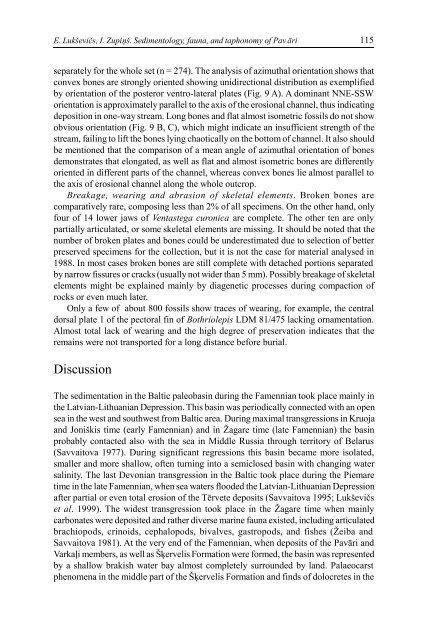Zemes un vides zinātnes Earth and Environment Sciences - Latvijas ...
Zemes un vides zinātnes Earth and Environment Sciences - Latvijas ...
Zemes un vides zinātnes Earth and Environment Sciences - Latvijas ...
You also want an ePaper? Increase the reach of your titles
YUMPU automatically turns print PDFs into web optimized ePapers that Google loves.
E. Lukševičs, I. Zupiņš. Sedimentology, fa<strong>un</strong>a, <strong>and</strong> taphonomy of Pav āri<br />
115<br />
separately for the whole set (n = 274). The analysis of azimuthal orientation shows that<br />
convex bones are strongly oriented showing <strong>un</strong>idirectional distribution as exemplified<br />
by orientation of the posteror ventro-lateral plates (Fig. 9 A). A dominant NNE-SSW<br />
orientation is approximately parallel to the axis of the erosional channel, thus indicating<br />
deposition in one-way stream. Long bones <strong>and</strong> flat almost isometric fossils do not show<br />
obvious orientation (Fig. 9 B, C), which might indicate an insufficient strength of the<br />
stream, failing to lift the bones lying chaotically on the bottom of channel. It also should<br />
be mentioned that the comparison of a mean angle of azimuthal orientation of bones<br />
demonstrates that elongated, as well as flat <strong>and</strong> almost isometric bones are differently<br />
oriented in different parts of the channel, whereas convex bones lie almost parallel to<br />
the axis of erosional channel along the whole outcrop.<br />
Breakage, wearing <strong>and</strong> abrasion of skeletal elements. Broken bones are<br />
comparatively rare, composing less than 2% of all specimens. On the other h<strong>and</strong>, only<br />
four of 14 lower jaws of Ventastega curonica are complete. The other ten are only<br />
partially articulated, or some skeletal elements are missing. It should be noted that the<br />
number of broken plates <strong>and</strong> bones could be <strong>un</strong>derestimated due to selection of better<br />
preserved specimens for the collection, but it is not the case for material analysed in<br />
1988. In most cases broken bones are still complete with detached portions separated<br />
by narrow fissures or cracks (usually not wider than 5 mm). Possibly breakage of skeletal<br />
elements might be explained mainly by diagenetic processes during compaction of<br />
rocks or even much later.<br />
Only a few of about 800 fossils show traces of wearing, for example, the central<br />
dorsal plate 1 of the pectoral fin of Bothriolepis LDM 81/475 lacking ornamentation.<br />
Almost total lack of wearing <strong>and</strong> the high degree of preservation indicates that the<br />
remains were not transported for a long distance before burial.<br />
Discussion<br />
The sedimentation in the Baltic paleobasin during the Famennian took place mainly in<br />
the Latvian-Lithuanian Depression. This basin was periodically connected with an open<br />
sea in the west <strong>and</strong> southwest from Baltic area. During maximal transgressions in Kruoja<br />
<strong>and</strong> Joniškis time (early Famennian) <strong>and</strong> in Žagare time (late Famennian) the basin<br />
probably contacted also with the sea in Middle Russia through territory of Belarus<br />
(Savvaitova 1977). During significant regressions this basin became more isolated,<br />
smaller <strong>and</strong> more shallow, often turning into a semiclosed basin with changing water<br />
salinity. The last Devonian transgression in the Baltic took place during the Piemare<br />
time in the late Famennian, when sea waters flooded the Latvian-Lithuanian Depression<br />
after partial or even total erosion of the Tērvete deposits (Savvaitova 1995; Lukševičs<br />
et al. 1999). The widest transgression took place in the Žagare time when mainly<br />
carbonates were deposited <strong>and</strong> rather diverse marine fa<strong>un</strong>a existed, including articulated<br />
brachiopods, crinoids, cephalopods, bivalves, gastropods, <strong>and</strong> fishes (Žeiba <strong>and</strong><br />
Savvaitova 1981). At the very end of the Famennian, when deposits of the Pavāri <strong>and</strong><br />
Varkaļi members, as well as Šķervelis Formation were formed, the basin was represented<br />
by a shallow brakish water bay almost completely surro<strong>un</strong>ded by l<strong>and</strong>. Palaeocarst<br />
phenomena in the middle part of the Šķervelis Formation <strong>and</strong> finds of dolocretes in the
















